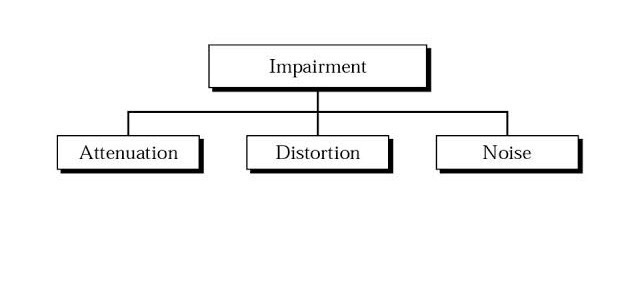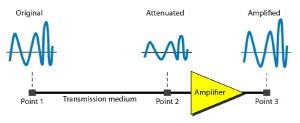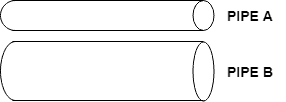a transmission medium is a physical path between the transmitter and the receiver i.e it is the channel through which data is sent from one place to another.
Types of transmission media
Transmission Media is broadly classified into the following types:

1. Guided Media:
It is also referred to as Wired or Bounded transmission media. Signals being transmitted are directed and confined in a narrow pathway by using physical links.
Features
- High Speed
- Secure
- Used for comparatively shorter distances
Types of guided media
(i) Twisted Pair Cable –
It consists of 2 separately insulated conductor wires wound about each other. Generally, several such pairs are bundled together in a protective sheath. They are the most widely used Transmission Media. Twisted Pair is of two types:
- Unshielded Twisted Pair (UTP):
This type of cable has the ability to block interference and does not depend on a physical shield for this purpose. It is used for telephonic applications. Advantages:
- Least expensive
- Easy to install
- High speed capacity
- Susceptible to external interference
- Lower capacity and performance in comparison to STP
- Short distance transmission due to attenuation
2. Shielded Twisted Pair (STP):
This type of cable consists of a special jacket to block external interference. It is used in fast-data-rate Ethernet and in voice and data channels of telephone lines.
Advantages:
- Better performance at a higher data rate in comparison to UTP
- Eliminates crosstalk
- Comparitively faster
- Comparitively difficult to install and manufacture
- More expensive
- Bulky
(ii) Coaxial Cable –
It has an outer plastic covering containing 2 parallel conductors each having a separate insulated protection cover. Coaxial cable transmits information in two modes: Baseband mode(dedicated cable bandwidth) and Broadband mode(cable bandwidth is split into separate ranges). Cable TVs and analog television networks widely use Coaxial cables.
Advantages:
- High Bandwidth
- Better noise Immunity
- Easy to install and expand
- Inexpensive
Disadvantages : Single cable failure can disrupt the entire network
iii) Optical Fibre Cable –
It uses the concept of reflection of light through a core made up of glass or plastic. The core is surrounded by a less dense glass or plastic covering called the cladding. It is used for transmission of large volumes of data.
The cable can be unidirectional or bidirectional. The WDM (Wavelength Division Multiplexer) supports two modes, namely unidirectional and bidirectional mode.
Advantages:
Increased capacity and bandwidth- Light weight
- Less signal attenuation
- Immunity to electromagnetic interference
- Resistance to corrosive materials
Disadvantages:
- Difficult to install and maintain
- High cost
- Fragile
Unguided media
It is also referred to as Wireless or Unbounded transmission media.No physical medium is required for the transmission of electromagnetic signals.
Features:
- Signal is broadcasted through air
- Less Secure
- Used for larger distances
Types of unguided media
(i) Radiowaves –
These are easy to generate and can penetrate through buildings. The sending and receiving antennas need not be aligned. Frequency Range:3KHz – 1GHz. AM and FM radios and cordless phones use Radiowaves for transmission
ii) Microwaves –
It is a line of sight transmission i.e. the sending and receiving antennas need to be properly aligned with each other. The distance covered by the signal is directly proportional to the height of the antenna. Frequency Range:1GHz – 300GHz. These are majorly used for mobile phone communication and television distribution.
(iii) Infrared –
Infrared waves are used for very short distance communication. They cannot penetrate through obstacles. This prevents interference between systems. Frequency Range:300GHz – 400THz. It is used in TV remotes, wireless mouse, keyboard, printer, etc.
Transmission impairment
There are basically three causes of transmission impairment

Attenuation
- Attenuation means a loss of energy.
- When a signal, simple or composite, travels through a medium, it loses some of its energy in overcoming the resistance of the medium. That is why a wire carrying electric signals gets warm.
- To compensate for this loss, amplifiers are used to amplify the signal.
- To show that a signal has lost or gained strength, engineers use the unit of the decibel.
- The decibel (dB) measures the relative strengths of two signals or one signal at two different points.
- The decibel is negative if a signal is attenuated and positive if a signal is amplified.

Distortion
- Distortion means that the signal changes its form or shape.
- Distortion can occur in a composite signal made of different frequencies.
- Each signal component has its own propagation speed through a medium and, therefore, its own delay in arriving at the final destination. Differences in delay may create a difference in phase.
- The shape of the composite signal is therefore not the same.

Noise
Noise is any unwanted disturbance of a useful signal that obscures its information content. Many different types of noise in data communication exist, and managing noise successfully requires the use of multiple techniques. Among the most common types of noise are electronic noise, thermal noise, intermodulation noise, cross-talk, impulse noise, shot noise and transit-time noise. Acoustic noise is also a factor for those working within networking office environments.

Network Throughput
Throughput is defined as “the amount of material or items passing through a system or process.” Relating this to networking, the materials are referred to as “packets” while the system they are passing through is a particular “link”, physical or virtual.
Furthermore, when discussing network throughput, the measurement is typically taken per unit time, between two devices, and represented as Bits per second (bps), Kilobit per second (Kbps), Megabits per second (Mbps), Gigabit per second (Gbps), and so on.
So for example, if a packet with a size of 100 bytes takes 1 second to flow from Computer_A to Computer_B, we can say the throughput between the two devices is 800bps.
Bandwidth vs. Throughput
Looking at the description above, one question that comes to mind is, “What is the difference between bandwidth and throughput?” To explain this difference, let’s use an analogy of water flowing through pipes.

Considering the two pipes shown above, which pipe do you think will pass more water through it? The default answer is PIPE B because that is a fatter pipe. However, the real answer to the question is that “it depends”.
If water is flowing at maximum capacity through both pipes, then PIPE B will carry more water through at a particular time. But what if much more water is coming in to PIPE A than PIPE B? Or, what if there is debris in PIPE B that is restricting the flow of water inside the pipe?
In summary, we can conclude that in ideal conditions and at maximum capacity, PIPE B will carry more water than PIPE A. However, any number of factors can cause more water to flow through PIPE A per unit time.
Using the analogy above, Bandwidth can be compared to the fatness of the pipes (i.e. the maximum and theoretical capacity of the pipe) while Throughput is the actual amount of water that flows through per unit time. Therefore, even though bandwidth will set a limit on throughput, throughput can be affected by a host of other factors.
Latency (Delay)
The latency or delay defines how long it takes for an entire message to completely arrive at the destination from the time the first bit is sent out from the source. We can say that latency is made of four components: propagation time, transmission time, queuing time and processing delay.
Latency = propagation time + transmission time + queuing time + processing delay
Propagation time
measures the time required for a bit to travel from the source to the destination. The propagation time is calculated by dividing the distance by the propagation speed.
Propagation time = Distance / (Propagation Speed)
The propagation speed of electromagnetic signals depends on the medium and on the frequency of the signal. For example, in a vacuum, light is propagated with a speed of 3 × 108 m/s. It is lower in air; it is much lower in cable.
Example: What is the propagation time if the distance between the two points is 12,000 km? Assume the propagation speed to be 2.4 × 108 m/sin cable.
We can calculate the propagation time as
Propagation time = (12000 * 1000) / (2.4 × 108) = 50 ms
The example shows that a bit can go over the Atlantic Ocean in only 50 ms if there is a direct cable between the source and the destination.
Transmission time
In data communications we don’t send just 1 bit, we send a message. The first bit may take a time equal to the propagation time to reach its destination; the last bit also may take the same amount of time. However, there is a time between the first bit leaving the sender and the last bit arriving at the receiver. The first bit leaves earlier and arrives earlier; the last bit leaves later and arrives later. The transmission time of a message depends on the size of the message and the bandwidth of the channel.
Transmission time = (Message size) / Bandwidth
Example: What are the propagation time and the transmission time for a 2.5-KB (kilobyte) message (an email) if the bandwidth of the network is 1 Gbps? Assume that the distance between the sender and the receiver is 12,000 km and that light travels at 2.4 * 108 m/s.
We can calculate the propagation and transmission time as:
Propagation time = (12000 * 1000) / (2.4 * 108) = 50 ms
Transmission time = (2500 * 8) / 109 = 0.02 ms
Note that in this case, because the message is short and the bandwidth is high, the dominant factor is the propagation time, not the transmission time. The transmission time can be ignored.
Example: What are the propagation time and the transmission time for a 5-MB (megabyte) message (an image) if the bandwidth of the network is 1 Mbps? Assume that the distance between the sender and the receiver is 12,000 km and that light travels at 2.4 * 108 m/s.
We can calculate the propagation and transmission times as:
Propagation time = (12000 * 1000) / (2.4 * 108) = 50 ms Transmission time = (5000000 * 8) / 106 = 40 s
Note that in this case, because the message is very long and the bandwidth is not very high, the dominant factor is the transmission time, not the propagation time. The propagation time can be ignored.
Queuing Time:
The third component in latency is the queuing time, the time needed for each intermediate or end device to hold the message before it can be processed. The queuing time is not a fixed factor; it changes with the load imposed on the network. When there is heavy traffic on the network, the queuing time increases. An intermediate device, such as a router, queues the arrived messages and processes them one by one. If there are many messages, each message will have to wait.
Processing delay
processing delay is the time it takes nodes to process the packet header. Processing delay is a key component in network delay. During processing of a packet, nodes may check for bit-level errors in the packet that occurred during transmission as well as determining where the packet’s next destination is.
Wavelength
Wavelength is a measure of distance a signal can travel in a period. It is the distance between corresponding points. The units of wavelength are meter, centimeters, etc.

The Wavelength depends on frequency and medium.
Frequency and Wavelength are inversely related to each other.
Wavelength = propagation speed/frequency